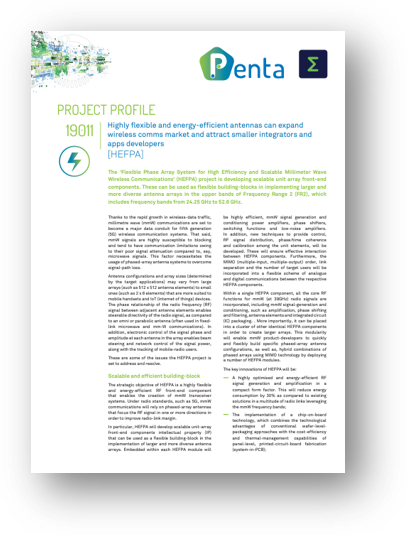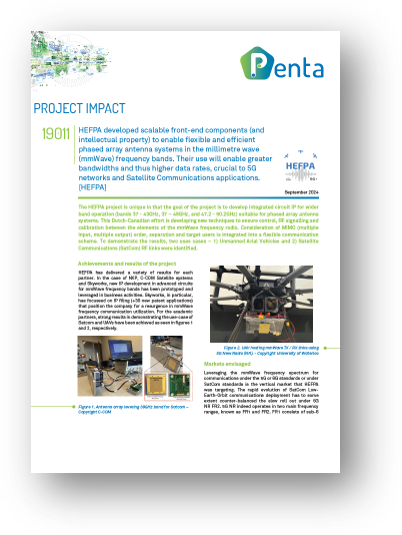Project status :
Recently completed
Project website :
https://hefpa.com/
Key application areas
 Energy
Energy  Digital Industry
Digital Industry Essential capabilities
 Systems and Components: Architecture, Design, and Automation
Systems and Components: Architecture, Design, and Automation
Connectivity and Interoperability
 Process Technology, Equipment, Materials and Manufacturing for Electronic Components & Systems
Process Technology, Equipment, Materials and Manufacturing for Electronic Components & Systems
PARTNER
C-COM Satellite Systems Inc / Carleton University / Eindhoven University of Technology / NXP Semiconductors Netherlands BV / Semiconductor Ideas to the Market BV (ItoM) / Skyworks Solutions Canada Inc. / University of Waterloo
C-COM Satellite Systems Inc / Carleton University / Eindhoven University of Technology / NXP Semiconductors Netherlands BV / Semiconductor Ideas to the Market BV (ItoM) / Skyworks Solutions Canada Inc. / University of Waterloo
Countries involved
 Canada
Canada  Netherlands
Netherlands Project leader(s)
Estelle HolopherneKey project dates
01 July 2020 - 31 December 2023HEFPA developed scalable front-end components (and intellectual property) to enable flexible and efficient phased array antenna systems in the millimetre wave (mmWave) frequency bands. Their use will enable greater bandwidths and thus higher data rates, crucial to 5G networks and Satellite Communications applications. [HEFPA]
The HEFPA project is unique in that the goal of the project is to develop integrated circuit IP for wider band operation (bands 37 – 43GHz, 37 – 48GHz, and 47.2 – 50.2GHz) suitable for phased array antenna systems. This Dutch-Canadian effort is developing new techniques to ensure control, RF signalling and calibration between the elements of the mmWave frequency radio. Consideration of MIMO (multiple input, multiple output) order, separation and target users is integrated into a flexible communication scheme. To demonstrate the results, two uses cases – 1) Unmanned Arial Vehicles and 2) Satellite Communications (SatCom) RF links were identified.
Achievements and results of the project
HEFPA has delivered a variety of results for each partner. In the case of NXP, C-COM Satellite systems and Skyworks, new IP development in advanced circuits for mmWave frequency bands has been prototyped and leveraged in business activities. Skyworks, in particular, has focussed on IP filing (+30 new patent applications) that position the company for a resurgence in mmWave frequency communication utilization. For the academic partners, strong results in demonstrating the use-case of Satcom and UAVs have been achieved as seen in figures 1 and 2, respectively.
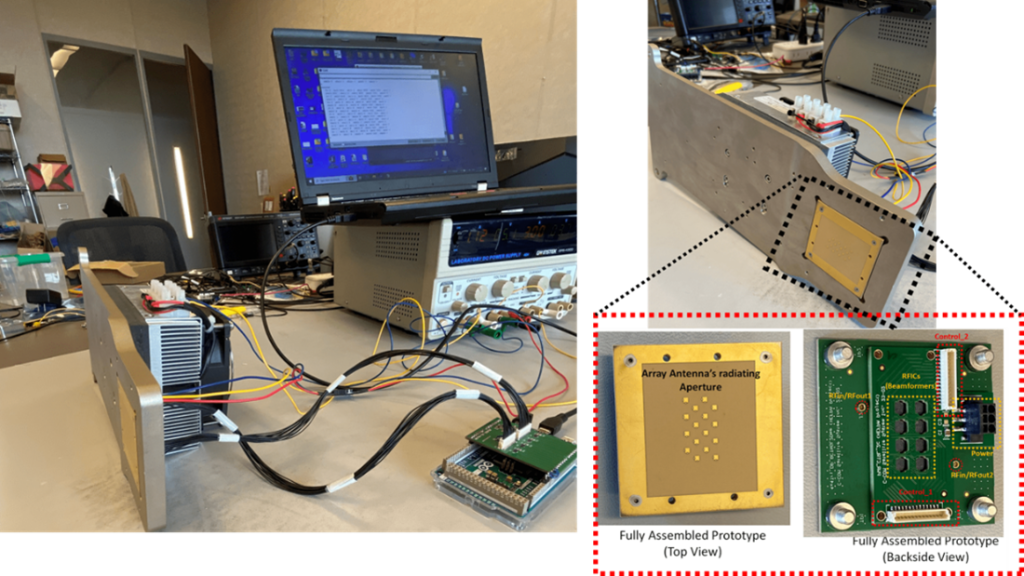
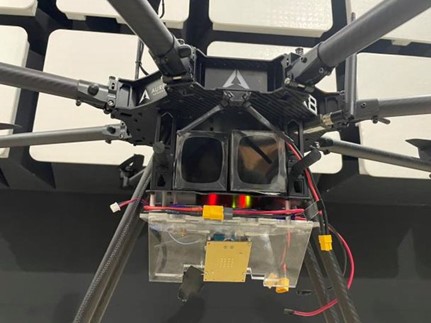
Markets envisaged
Leveraging the mmWave frequency spectrum for communications under the 5G or 6G standards or under SatCom standards is the vertical market that HEFPA was targeting. The rapid revolution of SatCom Low-Earth-Orbit communications deployment has to some extent counter-balanced the slow roll out under 5G NR FR2. 5G NR indeed operates in two main frequency ranges, known as FR1 and FR2. FR1 consists of sub-6 GHz frequencies, while FR2 comprises millimetre wave (mmWave) frequencies ranging from 24 GHz to 100 GHz.
Background, objectives of the project and challenges
See project proposal: cost effective and efficient implementation (low power, small area consumption) of 5G mmWave components is needed by the market. Millimeter wave (mmWave) frequency bands are strategic to benefit from greater bandwidths and thus higher data rates. However, deployment of mmWave radios is currently seen in military or commercial fixed
(point-to-point) systems that are engineered with custom or off-the-shelf elements suitable for fixed frequency operation typically at 28GHz [1]. Moreover, these systems use uniquely designed and rigid antenna assemblies. That is why mmWave wireless communications shall rely upon phased array antenna systems to overcome signal path loss.
HEFPA therefore developed scalable unit-array frontend components intellectual property (IP) that can be used as a flexible building-block in the implementation of larger and more diverse antenna arrays. While energy efficiency is crucially increased, the ability of each set of HEFPA components to work with adjacent assemblies in a flexible / reconfigurable manner is the core innovation of the project that solves the problem of diverse usecase application for mmWave communications.
Technological achievements
IP blocks and proof-points in multiple technologies have been designed, manufactured and measured. HEFPA developed the beam steering, the digital control overlay to permit multi-module phased array calibration and the beam steering. It includes hybrid MIMO topologies to improve the flexibility and advanced high reliability module. These blocks supported the mmWave transceiver blocks. Breakthroughs of the IP were reduced area consumption and power consumption. A demonstration was made using a drone acting as mmWave hub, to achieve a mmWave link bypass during a line-of-sight blockage. See figure 2. For Satcom a section of a 39 GHz active phased array antenna was build. See figure 1.
HEFPA generates new technologies:
— System-in-Package for 28/39GHz 5G
— Analog beamformer for 24.25-29.5 GHz – phase shifter section covering two bands (n257, n258) with one integrated circuit
— Beam optimization schemes for reduced power consumption
— Power amplifier efficiency improved to ~14% in highest power modes
— A synthesizer has been designed, manufactured and measured
— IP Generation and Board Level Array Demonstrators: UAV based mm-wave communication link
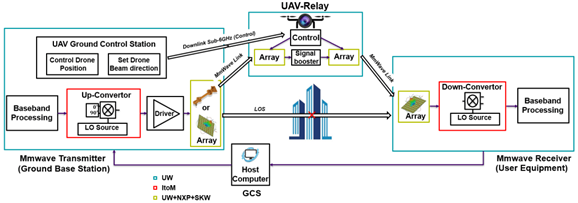
Copyright University of Waterloo
Additionally, HEFPA delivers a system/Board level integration of antenna array and beamforming integrated circuit with a compact footprint at mm-wave frequency:
— Develop active array calibration and DPD training methods that use near-field probes as feedback
— An active array calibration that allows for phasedependent phase and magnitude error correction
— A DPD training method that relaxes the constraints on the near-field feedback frequency response
A Q-band 4X4 phased array antenna (a building block for the receive band) in a package for the next-generation SATCOM applications has been developed during the course of the project. In term of impacts, HEFPA generated 38 patents, 13 journal articles, 16 conference papers, 4 workshops and invited talks, 2 Website articles, 7 MSc thesis (graduated) and 3 MSc thesis (ongoing), 2 PhD graduated and 5 PhD ongoing.
Market Potential
5G Markets – mmWave Radio Frequency Front End (RFFE) & Beamformer Solutions
During the HEFPA project, it was observed a retrenchment from Fixed Wireless Access (FWA) and mmWave in handsets thereby limiting the market potential of the project results in the near term. 3GPP, responsible for the development and maintenance of standards for mobile communications, introduced 2.5 – 5GHz mobile bands dominating RFFE market at the expense of mmWave adoption. Consequently, no significant mmWave adoption will be seen until 2028 except in fixed wireless access situations [2].
Satcom Markets – mmWave RFFE + Digitial Architectures
In contrast to the 5G NR situation, we have seen significant activity in Low Earth Orbit (LEO) and 3GPP Non-Terrestrial Networks (resurgence of S-band) and, in particular, new programs with dense constellations are planned (e.g. Starlink, OneWeb, Lightspeed, Kuiper). Skyworks leveraging the IP developed during HEFPA to add additional components to our High Reliability business unit. A recent report from BIS Research inc. published in 20213, the global satellite flat panel antenna market is estimated to reach over $18.39 billion in 2031 from $3.95 billion in 2021, a growth rate of 16.6%. The main markets mentioned are Defense & Government, Aviation, Maritime, Oil & Gas, Enterprise, Space, IoT, etc..
Societal & Economic Impact
Societal impact of the 5G deployment of HEFPA results are applicable in some key areas:
Enhanced Mobile Broadband:
— Faster downloads and uploads of large files.
— Smoother streaming of high-definition and even virtual reality content.
— Improved online gaming experiences with lower latency (response time).
Increased Network Capacity:
With mmWave’s wider spectrum availability, it can accommodate a much larger number of connected devices compared to existing networks. This is crucial for supporting the growing trend of Internet of Things (IoT) applications, especially in private / industrial networks.
Emerging Technologies:
mmWave’s capabilities pave the way for innovative applications like:
— Smart cities with better traffic management, connected infrastructure, and remote monitoring.
— Augmented reality experiences with real-time data overlays.
— Telemedicine advancements with high-resolution remote consultations and surgeries.
Economic Growth:
The deployment of mmWave infrastructure can stimulate economic activity through
— Creation of new jobs in network development, maintenance, and application creation:
- 7 MSc thesis (graduated) + 3 MSc thesis (ongoing)
- 2 PhD graduated + 5 PhD ongoing
- Continued capability growth at Skyworks Solutions Canada Inc. with over 30 new hires into the Ottawa offices.
- In NXP Semiconductors, mmWave design group hired engineers & staff is now working on mmWave application maintaining IP developed in HEFPA.
— Increased productivity and efficiency in various industries that rely on high-speed data transfer.
— Boosting innovation and development of new technologies and services.
Patents, Standardisation, Publications
The HEFPA record of dissemination is impressive with over 38 patents (incl. pending patents), 13 journal articles, 16 conference papers. In the last three years, at least one of the HEFPA papers was selected as one of the top 50 papers at IMS (prime international microwave conference). In addition, the partnership had 4 workshops and invited talks and 2 website articles.
In addition, standardization contributions for 5G NTN have been initiated based on the growth in interest for these types of networks.
Future Developments
Skyworks Inc. has undertaken various business engagements including SpaceX and Telesat Lightspeed. Fundamentally, in view of the slow response of the 5G NR FR2 market, Skyworks has positioned itself for a rebound in mmWave spectrum deployment (3GPP NTN and 6G) with a strong foundation in IP established. Moreover, Skyworks has identified the missing Technology elements needed for internal development including high frequency BAW and GaN HEMTs. NXP has build upon the work towards a 100 GHz telecom demonstrator (shown
at MWC2023) with Ericsson. NXP continues with multiple programs (IPCEI, XECS, National Growth Fund, KDT, NWO, Curie, NXP fellowship program) with TU/e. C-COM will continue its program with University of Waterloo for Q/V for SatCom.
There is a high potential of usability of HEFPA building blocks in other domains, in the sense that any use-case that is going to be reliant upon high-bandwidth, large data throughput wireless communications will benefit from being able to deploy HEFPA components in the build-up of the phased array that is needed. The business relevance of the HEFPA components is that it reduces complexity in the formation and deployment of mmWave radio links; enables flexibility including reuse of supporting infrastructure to a variety of antenna array factors; and reduces energy consumption.
[1] Source: Skyworks
[2] Source: NXP
[3] Source: BIS Research, Satellite Flat Panel Antenna Market – A Global and Regional Analysis, 2024-2034, Focus on Application, Steering Mechanism, Type, Frequency Band, and Country-wise Analysis. https://bisresearch.com/industry-report/satellite-flat-panel-antenna-market.html


